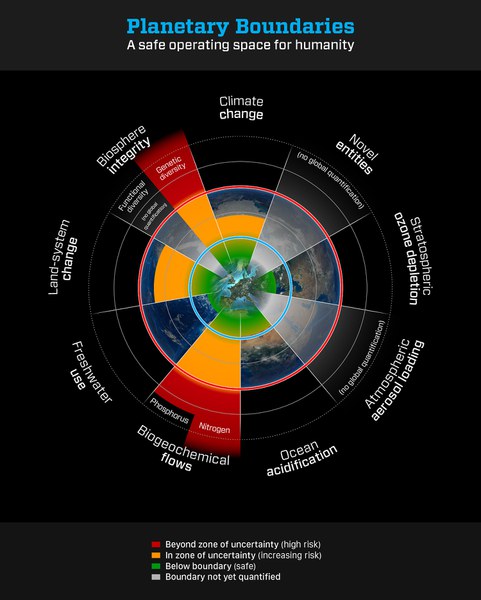Four of nine planetary boundaries now crossed
Four of nine planetary boundaries have now been crossed as a result of human activity, says an international team of 18 researchers in the journal Science.
The four are: climate change, loss of biosphere integrity, land-system change, altered biogeochemical cycles. The scientists say that two of these, climate change and biosphere integrity, are “core boundaries” – significantly altering either of these would “drive the Earth System into a new state”. The team will present their findings in seven seminars at the World Economic Forum in Davos (21-25 January).
The concept of planetary boundaries, developed by a global community of scholars with participation of the Potsdam Institute for Climate Impact Research (PIK) and first published in 2009, identifies nine global priorities relating to human-induced changes to the environment. The science shows that these nine processes and systems regulate the stability and resilience of the Earth System – the interactions of land, ocean, atmosphere and life that together provide conditions upon which our societies depend. The new research confirms the original set of boundaries and provides updated analysis and quantification for several of them (see table at end). To achieve some of these quantifications, a PIK computer model (LPJmL) simulating human impacts on Earth’s water resources and ecosystems was key.
“Transgressing a boundary increases the risk that human activities could inadvertently drive the Earth System into a much less hospitable state, damaging efforts to reduce poverty and leading to a deterioration of human wellbeing in many parts of the world, including wealthy countries,” said lead author Will Steffen from the Stockholm Resilience Centre, Professor at the Stockholm University and the Australian National University, Canberra. “In this new analysis we have improved our quantification of where these risks lie.”
On the regional scale, even more boundaries are crossed
Even some boundaries that have not yet been crossed at the planetary scale were found to exceed regional tolerance limits, such as freshwater use in the western US and in parts of southern Europe, Asia and the Middle East. “The challenges for society to stay within several planetary boundaries require balanced policies,” said co-author Dieter Gerten of PIK. The boundaries are closely interlinked, and preventive measures relating to one of them can have negative repercussions on another one. “For example, if irrigation was reduced to stay below the boundary for freshwater use, cropland may have to be expanded as a compensation measure, leading to further transgression of the boundary for land-system change,” Gerten explained. “Implementing methods to use water more efficiently in agriculture can help sort out this dilemma and at the same time increase global food production.”
Regarding climate change, the team argue that carbon dioxide levels should not cross 350 parts per million (ppm) in the atmosphere. The current level is about 399 ppm (December 2014), growing by about 3 ppm per year. “This boundary is consistent with a stabilisation of global temperatures at about 1.5 degrees above pre-industrial levels,” said co-author Professor Johan Rockström, director of the Stockholm Resilience Centre, who will present the new findings at the World Economic Forum. In December, nations will meet in Paris to negotiate an international emissions agreement to attempt to stabilise temperatures at 2 degrees above pre-industrial levels. “Our analysis suggests that, even if successful, reaching this target contains significant risks for societies everywhere,” said Rockström. “Two degrees must therefore be seen not only as a necessary but also a minimum global climate target.”
Investigating the implications of global risks for national policy-making
PIK maintains an extensive collaboration with the Stockholm Resilience Centre on the topic of planetary boundaries. Under the leadership of Wolfgang Lucht, Co-Chair of PIK’s department of Earth System Analysis, PIK is a founding member of the Planetary Boundaries Research Network (PB.net) to coordinate this science. PIK researchers led by Wolfgang Lucht have also recently launched a project funded by the German Environmental Agency (Umweltbundesamt) to specifically investigate the implications of planetary boundaries for national policy making.
Article:
Steffen, W., Richardson, K., Rockström, J., Cornell, S., Fetzer, I., Bennett, E.M., Biggs, R., Carpenter, S.R., de Vries, W., de Wit, C.A., Folke, C., Gerten, D., Heinke, J., Mace, G.M., Persson, L.M., Ramanathan, V., Reyers, B., Sörlin, S. (2015): Planetary Boundaries: Guiding human development on a changing planet. Science (Express, online)[DOI:10.1126/science.1259855]
Related weblinks:
www.pb-net.org
www.stockholmresilience.su.se
www.pik-potsdam.de/research/earth-system-analysis/projects/flagships/open
|
Planetary Boundary |
Control Variable(s) |
Boundary The value in brackets indicates the estimated zone of uncertainty |
Current Value |
|
Climate change |
Atmospheric CO2concentration, ppm
Energy imbalance at top-of-atmosphere, (Watts per metre squared, Wm-2) |
350 ppm CO2 (350-450 ppm)
Energy imbalance: +1.0 W m-2 (+1.0-1.5 W m-2) |
396.5 ppm CO2
2.3 W m-2 (1.1-3.3 W m-2) |
|
Change in biosphere integrity
|
Genetic diversity:Extinction rate
|
Genetic: less than 10 extinctions per million species-years (E/MSY), (10-100 E/MSY)
|
100-1000 E/MSY
84%, applied to southern Africa only |
|
Stratospheric ozone depletion
|
Stratospheric O3concentration, Dobson Units |
<5% reduction from pre-industrial level of 290 Dobson Units (5%–10%), assessed by latitude |
Only transgressed over Antarctica in Austral spring (~200 DU) |
|
Ocean acidification
|
Carbonate ion concentration, average global surface ocean saturation state with respect to aragonite (Ωarag ) |
≥80% of the pre-industrial aragonite saturation state of mean surface ocean, including natural diel and seasonal variability ( ≥80%– ≥70%) |
~84% of the pre-industrial aragonite saturation state |
|
Biogeochemical flows: (Phosphorus and Nitrogen cycles)
|
Phosphorus cycle: Global: Phosphorus flow from freshwater systems into the ocean Regional: Phosphorus flow from fertilizers to erodible soils
Nitrogen cycle: Global: Industrial and intentional biological fixation of nitrogen.
|
Phosphorus cycle: Global: 11 Tg P yr-1 (11-100 Tg P yr-1)
Regional: 6.2 Tg yr-1 mined and applied to erodible (agricultural) soils (6.2-11.2 Tg yr-1). Boundary is a global average but regional distribution is critical for impacts.
62 Tg N yr-1 (62-82 Tg N yr-1). Boundary acts as a global ‘valve’ limiting introduction of new reactive nitrogen to the Earth System, but regional distribution of fertilizer nitrogen is critical for impacts. |
~22 Tg P yr-1
~14 Tg P yr-1
~150 Tg N yr-1
|
|
Land-system change
|
Global: area of forested land as % of original forest cover
Biome: area of forested land as % of potential forest |
Global: 75% (75-54%) Values are a weighted average of the three individual biome boundaries and their uncertainty zones
Tropical: 85% (85-60%) Temperate: 50% (50-30%) Boreal: 85% (85-60%) |
62% |
|
Freshwater use
|
Global: Maximum amount of consumptive blue water use (km3yr-1)
Basin: Blue water withdrawal as % of mean monthly river flow |
Global: 4000 km3 yr-1 (4000-6000 km3 yr-1)
Basin: Maximum monthly withdrawal as a percentage of mean monthly river flow. For low-flow months: 25% (25-55%); for intermediate-flow months: 30% (30-60%); for high-flow months: 55% (55-85%) |
~2600 km3 yr-1 |
|
Atmospheric aerosol loading
|
Global: Aerosol Optical Depth (AOD), but much regional variation
Regional: AOD as a seasonal average over a region. South Asian Monsoon used as a case study |
Regional: (South Asian Monsoon as a case study): anthropogenic total (absorbing and scattering) AOD over Indian subcontinent of 0.25 (0.25-0.50); absorbing (warming) AOD less than 10% of total AOD |
0.30 AOD, over South Asian region |
|
Introduction of novel entities
|
No control variable currently defined |
No boundary currently identified, but see boundary for stratospheric ozone for an example of a boundary related to a novel entity (CFCs) |
|









